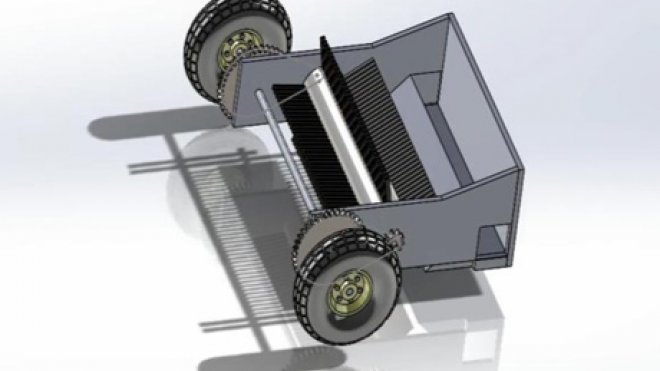Student Engineers from RWU Capture Top Honors in FAA Competition
Two teams of students awarded for innovative aviation solutions to improve jetway lighting, runway debris removal

BRISTOL, R.I. – By developing practical, innovative airport technologies to address real-world challenges facing the aviation industry, two teams of engineering students from Roger Williams University earned top honors in this year’s Federal Aviation Administration-sponsored university design competition.
Four Class of 2015 graduates – Hy Dinh, Emily Field, Andrew Hannigan and Kristen Tetreault – captured first place in the airport environmental interactions category. And two fellow School of Engineering, Computing and Construction Management students – Ryland Brickner-McDonald and Mohamad Ghulam – landed first place (tied with a team from Binghamton University) in the airport operations and maintenance category.
The victories in the University Design Competition for Addressing Airport Needs, sponsored by the FAA and managed by the Transportation Research Board Airport Cooperative Research Program, mark the second consecutive year in which RWU has captured top honors. Last year, a team of four engineering students earned first place in the runway safety category for a low-cost wind-shear detection system.
Professor of Engineering Linda A. Riley, who served as faculty advisor on what was the senior capstone project for each student, says each team’s refusal to give up – even when industry professionals offering feedback called their ideas impractical or not worth pursuing – was key to their success.
“Seasoned scientists are constrained by what they know and what they have done, but the minds and the dispositions of these undergraduate students are uncluttered,” Riley says. “I encourage them to keep an open mind, to explore fringe approaches to the problems they’re investigating, to embrace that discovery and then to apply it. They end up creating practical, innovative solutions that nobody in the world has come up with before.”
The four-student team competing in the airport environmental interactions challenge, which required participants to consider how airport operations affect the environment, created a design titled “Piezoelectric Carpet System – Design of a Self-Sustaining Affordable Energy Generating System for Airports.”
The system uses the energy of a human step to illuminate LED lights on carpets of jet bridges – the walkway connections between airport terminals and aircraft doors – to create a sustainable, cost-effective lighting solution. The students built a functional prototype to demonstrate piezoelectricity, which converts mechanical energy into electrical energy that can be stored and used for lighting, sound and data collection.
“Piezoelectric solutions have been tried, but they’ve never been affordable,” Riley says. “The students’ system was cost-effective compared to existing approaches to lighting, which is what makes it so appealing.”
In creating an entry titled “Foreign Object Debris Removal Machine,” Brickner-McDonald and Ghulam faced the task of designing a system to improve methods for detecting and removing stray pieces of material (steel, plastic, asphalt or passenger baggage, for example) that could potentially damage an aircraft traveling on a runway or taxiway.
The students’ solution is distinct from other debris removal systems in that no extra vehicle is needed to sweep the airport surfaces – their machine is designed to be retrofitted between the front and rear axles of baggage carts. They created a prototype with input from airline managers and tested a full-scale version on an existing baggage cart in partnership with Delta Airlines.
The winning Roger Williams University teams will receive their first place awards and present their solutions at the National Academies Keck Center in Washington on July 17; later that day, they will share their designs as keynote luncheon speakers at the Airport Consultants Council’s Airports Technical Workshop.
Volunteer panels of aviation industry experts, academic practitioners and representatives from the FAA selected the winning proposals for the competition, which seeks to engage students at U.S. colleges and universities in addressing issues facing airports while providing educational experiences and exposure to aviation and airport-related careers.